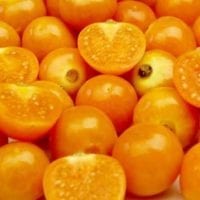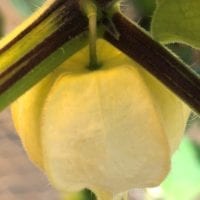News
CRISPR tames the wild groundcherry
ITHACA, NY – You might not have heard of the groundcherry, or at least, never tasted one. But that could soon change thanks to research from the Van Eck Laboratory at Boyce Thompson Institute (BTI).

The groundcherry (Physalis pruinosa) is approximately the same size as a cherry tomato, but with a much sweeter flavor. The tropical-tasting fruit is also a powerhouse in terms of nutritional value. Packed with Vitamin C, Vitamin B, beta-carotene, phytosterols, and antioxidants, plus anti-inflammatory and medicinal properties, this tiny fruit might just be the next superfood.
“We feel there is potential for these to become a specialty fruit crop and to be grown on a larger scale in the US,” said Joyce Van Eck, associate professor at BTI.
However, even with their delicious flavor and nutritional value, groundcherries remain an underutilized crop in the United States. Several characteristics make them unsuitable for large-scale agriculture. In the October 1, 2018 issue of Nature Plants, Van Eck and colleagues present research which could change that and make groundcherries a common household name thanks to the genome editing tool CRISPR.
CRISPR has great promise for increasing crop productivity, especially for orphan crops such as groundcherries, which often contain undesirable characteristics resembling wild relatives. Leveraging knowledge from model crops (such as the tomato) can improve plant architecture (growth habit), flower production, fruit size, and more.
 Selections for mutations in tomatoes have led to improvements in yield and Van Eck and her collaborator, Zach Lippman, at the Cold Spring Harbor Laboratory hypothesized that groundcherry genes could be similarly modified for immediate improvements. One concern with the groundcherry is its weedy growth habit. Genetic alterations have led to changes in the hormone that regulates flowering, producing plants which are more compact with fruit in clusters. They also targeted ways to increase fruit size and weight through a CRISPR-generated mutation, leading to fifty-percent more fruit along a given stem and more seedy sections in each fruit.
Selections for mutations in tomatoes have led to improvements in yield and Van Eck and her collaborator, Zach Lippman, at the Cold Spring Harbor Laboratory hypothesized that groundcherry genes could be similarly modified for immediate improvements. One concern with the groundcherry is its weedy growth habit. Genetic alterations have led to changes in the hormone that regulates flowering, producing plants which are more compact with fruit in clusters. They also targeted ways to increase fruit size and weight through a CRISPR-generated mutation, leading to fifty-percent more fruit along a given stem and more seedy sections in each fruit.
“It’s exciting that we can take what we have learned in tomato and apply it to distantly related species,” said Van Eck.
Van Eck is also focused on fixing problems caused by fruit drop. Groundcherries drop to the ground, often before fully ripening.

This puts the fruit at risk for damage and creates a labor-intensive harvest process. In addition, fruit having to be gathered up from the ground causes concerns for food safety with potential for foodborne illness. A jointless mutation in tomatoes could provide the inspiration for using gene-editing to stop fruit drop in groundcherries.
“Physalis is the perfect candidate for looking at getting the fruit to not drop,” said Van Eck. “Gene editing might be the only way to fix this in the groundcherry.”
This study represents the first step towards improving the groundcherry and this work could be extended to target additional genes benefiting a range of consumer desirable traits.
Learn more about the Van Eck Lab’s work on the Physalis Improvement Project webpage.
Citation
Z. Lemmon et al. ‘Rapid improvement of domestication traits in an orphan crop by genome editing’ was published on October 1, 2018, Nature Plants. DOI: http://dx.doi.org/10.1038/s41477-018-0259-x


